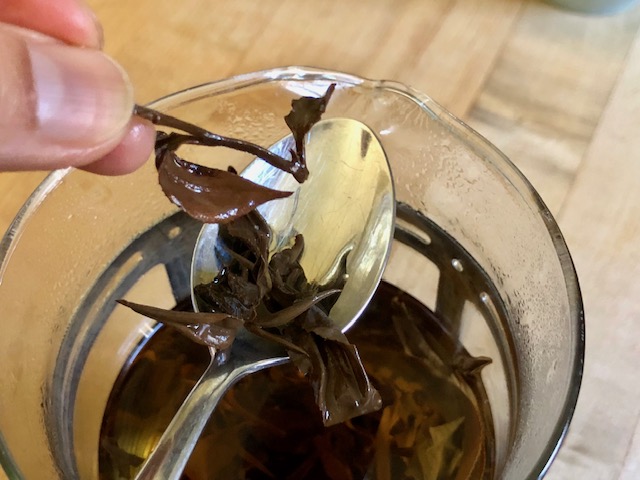This is the third post in my Unexpected Delights series, featuring a surprise reunion and bug-eaten “eastern beauty” oolong tea.

On our most recent trip to Taiwan, we went on a hike with my mom at Lion’s Head Mountain (獅頭山, Shitou Shan), next to the village she grew up in Miaoli County. As a child, she and her family walked through farm fields and forest to reach the temples on the mountain, where they gathered and practiced with Buddhist, Confucian and Taoist communities and cousins who lived there as monastics. These days, there is a well-maintained mountain road that zigzags through the forest. It’s safer to drive to the mountain trailhead than walk there from our ancestral home.
As my uncle drove us there, I noticed a house next to the trailhead with its lower floor open as a shop. Lots of family businesses in Taiwan still operate little shops out of their homes like this.
“What’s that?” I asked my uncle in Mandarin.
“Oh! That’s a tea shop. Want to check it out?” Then after a long pause, he turned to my mom and asked in Hakka, “Do you know 劉蘭菊 (Liu Lan Ju)? She’s about your age…”
My mom searched her memory banks and slowly her eyes grew wide. “Oh yes! I remember her. We went to elementary school together!” That was over 60 years ago.
I clapped in delight, “Let’s go! Maybe she’s there!”
Sure enough, my mom’s elementary school classmate was there. In classic no-frills Hakka fashion, after a quick re-introduction, Mrs. Liu said, “You’re lucky I’m here! I’m usually up on the mountain farm working at this hour!”

It was a magical moment for me. A confluence of so many things that I love: the unexpected delight of a chance reunion, our family’s roots in my mom’s Hakka community, the wild tropical mountain forest, our spiritual traditions, a mom-and-pop shop, tea grown by our neighbors and old friends, my family there to experience it with me, and the universe bringing all these strands together. I was elated. We asked about their farm and tea.
“Most hikers come to buy bottled iced teas, but you are different,” Mrs. Liu said with a laugh. “We’ll show you our tea leaves. We have a small tea field on the mountain side; it’s not a lot. For now, we just sell locally in our shop. This is what we have left from this year’s harvest, just a month or two ago.”
She, her husband and son opened a couple of large metal barrels and poured out the delicate, downy brown tips of “eastern beauty” oolong tea (東方美人茶, Dongfang meiren cha) onto one straw mat and beautiful emerald whole green tea leaves onto another mat.

I had been on a quest to get “eastern beauty” tea on this trip. This special bug-eaten tea originates from my family’s home area near Beipu and Emei Lake. The tea plant has to be grown without pesticides to allow a tiny leafhopper (Jacobiasca formosana) to feed on its leaves and stems, leading the plant to excrete a defensive terpene substance that turns its leaves white and impart a sweet honey-like taste.

The leafhopper bites also jump-start the oxidation of the leaves, which turns the tips brown and reduces its bitter vegetal flavors. Farmers then hand-pick the tiny buds and top two leaves. This makes for beautiful, delicate dark brown leaves with whitish downy tips and a vibrant amber-colored tea that is fragrant, smooth and honey-sweet.


My family calls this tea 椪風茶, phong-fûng chhà, or “braggart’s tea,” a hilarious foil to the “eastern beauty tea” name and is reflective of its origins in our family’s rural farming community. The story, as my uncle tells it, goes like this: Tea farmers from this region of Taiwan have long-known about bug-eaten tea. Because the leaves were chewed up and discolored, they kept these leaves for themselves to drink. The Europeans didn’t want buggy imperfect tea. But they knew the tea tasted special and different. It was ugly delicious. Sometime in the late 1800s, one of the farmers decided to market the tea with a fancy name so it would appeal to the European exporters. He named it “eastern beauty” oolong tea and convinced the exporters to purchase it from him at a high price. When he came back to Miaoli and told everyone what happened, they couldn’t believe how much money he made off this bug-eaten tea and started calling it “braggart’s tea.”
The day before we stumbled upon Mrs. Liu’s tea shop, we had gone to another neighbor’s farm at Emei Lake, a larger and fancier braggart’s tea operation, complete with a beautiful tea tasting table, show room and pretty branded packaging. I had already spent a small fortune on tea, but this tea was different. It was magical, divine.
Even my uncle, a very practical man, seemed to think so. He inhaled the fragrant scent from the downy brown leaves and whispered to me, “You know, this tea is different. It’s fresher and grown on this mountain in small batches with a lot of care.”

I didn’t need much convincing. We happily bought several containers of Mrs. Liu and family’s braggart’s tea and their green tea. Mrs. Liu’s son, who is hoping to grow their tea shop business, was also delighted by our visit and shared their Line address with me:
After we shared our gratitude and goodbyes, we started our ascent up the mountain to the temples, already feeling blessed.

Coming soon: posts about my family’s tea farming in Taiwan and a guide to tea from Taiwan.
